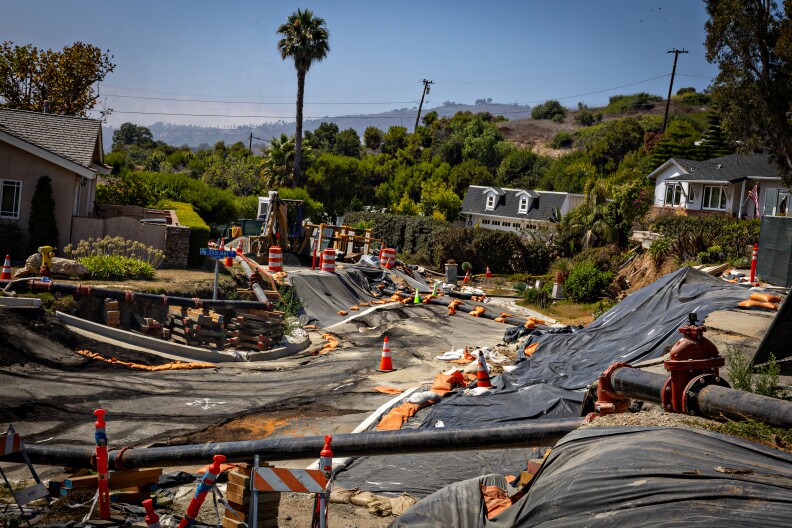Officials say the land underneath Rancho Palos Verdes is moving at approximately 1 foot per week. And while it's been moving slowly for thousands of years, construction in the mid-1950s greatly accelerated the slippage and the last two years of wet winters have only caused it to move more.
So, what is it about the land in this particular area that makes it so susceptible to slippage on a big enough scale to uproot homes and the families who live there? We asked a geologist to find out.
Water water everywhere
The biggest driving force behind the landslide? Water trapped in the ground, said Mike Phipps, principal engineering geologist with the geotechnical engineering firm Cotton, Shires and Associates, which is contracting with the city of Rancho Palos Verdes.
"We've known for a long time there's water in the landslide, but what we've now discovered is that there's water underneath the landslide that's under significant, tremendous pressure, and that pressure needs to be relieved," Phipps told LAist's daily news program AirTalk, which airs on 89.3 FM.
The primary approach to relieving that pressure, Phipps said, are dewatering wells. But those wells require power to function, and power has been cut off to the area. Phipps said the city is exploring options like generators and solar power to try and get the dewatering wells back online.
In June, the city started drilling holes 250 feet deep into the ground to try and find out where the water was collecting underground. Once the drilling is complete and the water located, the city intends to insert hydraugers to help drain it.
The makeup of a landslide
Phipps said the land movement happening in Rancho Palos Verdes is called a translational landslide — this one measures over a mile long and a mile wide. He says it's tending to be more uplift than lateral movement, dropping vertically at the top and rising up at its toe.

"So what we're seeing is some uplift down in the beach area where the landslide is actually coming out the near shore zone. And there's a new coastline forming in the Portuguese Bend landslide portion of the overall complex, so the ground is rising up there significantly in the Portuguese Bend Club and areas west of that," he said.
To make matters worse, there are two landslides at play — a shallower one that initially caused red-tagging of homes and a deeper one that's moving even faster.
"We've known for a long time there's water in the landslide, but what we've now discovered is that there's water underneath the landslide that's under significant, tremendous pressure, and that pressure needs to be relieved."
Phipps said the shallower one is well-defined over decades of studies, but it's the deeper one that's part of a larger complex that he says seems to be moving as a unit.
"It is a Herculean task to try to stabilize that big of a mass that's moving into the ocean, and my biggest question is whether the measures that we're going to implement to try...to relieve that pressure...are going to work," he said.
Phipps added that there's also the issue of enduring the cost of this dewatering and pressure relief over a long period of time. But he noted that it's not unprecedented to stabilize a land mass of this size.
Resources for those in landslide area
Check if your home is in the affected zones: https://protect.genasys.com/search.
The city states on its website that it is working to identify “hotels and other accommodations that can offer discounted rates for residents.” A list is available here.
For updates, the city directs residents to rpvca.gov/landmovement and PVPready.gov.
Listen to the full conversation
You can hear Mike Phipps' full interview with LAist's AirTalk below, as well as comments from Los Angeles County Supervisor Janice Hahn, whose district includes Rancho Palos Verdes.










